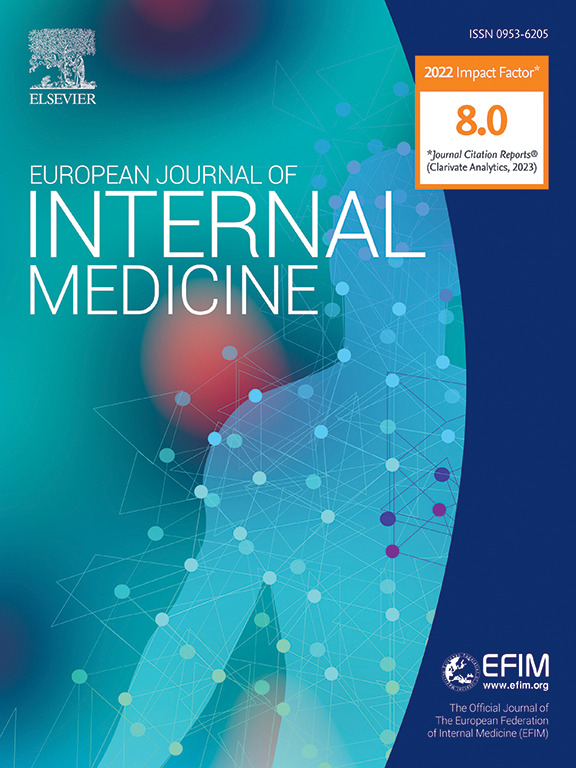Excess mortality of critically ill patients aged ≥90 years in intensive care units: A retrospective cohort study
IF 6.1
2区 医学
Q1 MEDICINE, GENERAL & INTERNAL
引用次数: 0
Abstract
Introduction
The number of elderly patients (≥90 years) admitted to intensive care units (ICUs) is continuously increasing. Survival estimations that differentiate into population and excess mortality are lacking but might be warranted given the higher baseline mortality in this group.
Methods
We evaluated excess mortality and risk factors in 1076 ICU patients ≥90 treated at the University Medical Center Hamburg-Eppendorf, Germany, from 2008 to 2019 by relative survival analysis. The Human Mortality Database of the German population served as reference.
Results
Population mortality – vulgo baseline mortality – accounted for 22.2 % of the observed 1-year mortality rate of 57.8 %. Within the tenth and eleventh decade of life, excess mortality was not significantly influenced by age - neither in ICU patients (HR 0.98 (0.94–1.03), p = 0.46) nor in ICU survivors (HR 0.96 (0.91–1.02), p = 0·15, each per year). Yet, SAPS-II, SOFA scores, dementia, aortic valve stenosis, myocardial infarction and other factors significantly influenced survival. The initial excess mortality rate was high after ICU admission (excess mortality risk λ=0.059 for all patients), but lower after ICU survival (λ=0.022). After around 100 days, the excess mortality risk had disappeared.
Discussion
In the largest dataset analyzed to date, we were able show that age did not significantly affect excess mortality of ICU patients aged 90 years or older. With respect to the severity of their illness, excess mortality of patients aged 90 years and older in ICUs is within an adequate range. Briefly after patients have left the ICU alive, mortality equals that of the general population.
重症监护病房≥90岁危重患者的超额死亡率:一项回顾性队列研究
导读:入住重症监护病房(icu)的老年患者(≥90岁)数量不断增加。目前缺乏区分人口死亡率和超额死亡率的生存估计,但考虑到该组较高的基线死亡率,这可能是有理由的。方法:通过相对生存分析,对2008年至2019年在德国汉堡-埃彭多夫大学医学中心接受治疗的1076例≥90岁ICU患者的超额死亡率和危险因素进行评估。德国人口死亡率数据库作为参考。结果:人群死亡率(基线死亡率)占观察到的1年死亡率(57.8%)的22.2%。在生命的第10年和第11年,年龄对超额死亡率没有显著影响——无论是ICU患者(HR 0.98 (0.94-1.03), p = 0.46)还是ICU幸存者(HR 0.96 (0.91-1.02), p = 0.15,每年)。而SAPS-II、SOFA评分、痴呆、主动脉瓣狭窄、心肌梗死等因素对生存率有显著影响。入院后的初始超额死亡率较高(所有患者的超额死亡率风险λ=0.059),但在ICU存活后较低(λ=0.022)。大约100天后,额外的死亡风险消失了。讨论:在迄今为止分析的最大数据集中,我们能够显示年龄对90岁或以上ICU患者的超额死亡率没有显着影响。就病情严重程度而言,90岁及以上icu患者的超额死亡率在适当范围内。患者活着离开ICU后不久,死亡率与一般人群相当。
本文章由计算机程序翻译,如有差异,请以英文原文为准。
求助全文
约1分钟内获得全文
求助全文
来源期刊
CiteScore
9.60
自引率
6.20%
发文量
364
审稿时长
20 days
期刊介绍:
The European Journal of Internal Medicine serves as the official journal of the European Federation of Internal Medicine and is the primary scientific reference for European academic and non-academic internists. It is dedicated to advancing science and practice in internal medicine across Europe. The journal publishes original articles, editorials, reviews, internal medicine flashcards, and other relevant information in the field. Both translational medicine and clinical studies are emphasized. EJIM aspires to be a leading platform for excellent clinical studies, with a focus on enhancing the quality of healthcare in European hospitals.

 求助内容:
求助内容: 应助结果提醒方式:
应助结果提醒方式:


